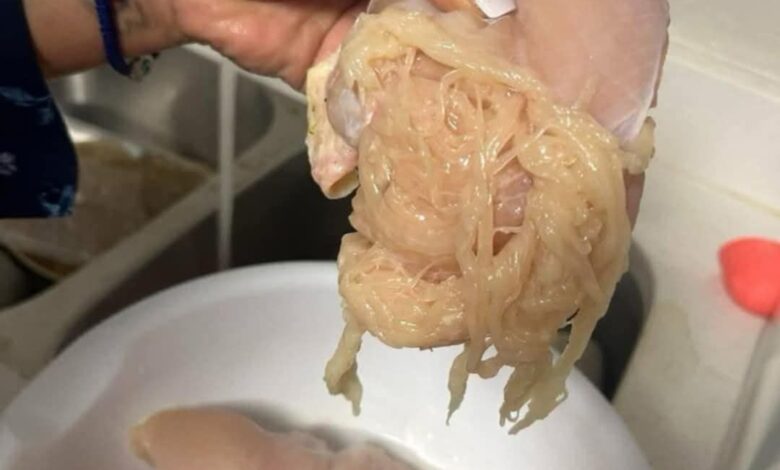Understanding Modern Chicken Production: What Consumers Need to Know About Meat Quality

A Consumer’s Surprising Kitchen Discovery
When preparing dinner for her family, Texas mother Alesia Cooper from Irving encountered an unexpected situation that would spark widespread discussion about modern food production. While washing chicken breast purchased from a local grocery store, she noticed the meat had an unusual texture that separated into stringy, spaghetti-like strands.
The Viral Food Safety Discussion
Cooper’s social media post about her cooking experience quickly gained attention, generating thousands of comments and shares. Her March 21st post documented the unusual chicken breast texture, leading to widespread consumer discussion about meat quality and food production methods.
“I was cooking my kids dinner a couple of weeks ago and was cleaning my meat like I normally do, and when I went back to start cooking, it turned into this,” Cooper explained in her viral post, which included photos of the stringy chicken breast.
Consumer Reactions and Food Safety Concerns
The post prompted numerous responses from concerned consumers, with many sharing their own experiences and theories about modern meat production. Comments ranged from concerns about food processing methods to questions about chicken farming practices and food safety standards.
Some social media users expressed concerns about laboratory-grown meat alternatives, while others questioned whether the chicken was produced using non-traditional methods. The discussion highlighted growing consumer interest in understanding how their food is produced and processed.
Understanding Modern Chicken Production
Food industry experts and agricultural scientists provide a different explanation for the unusual chicken texture. According to research published in food science journals, this phenomenon is related to modern chicken breeding and production practices rather than artificial meat alternatives.
The Science Behind Chicken Texture Changes
Dr. Massimiliano Petracci, a professor of agriculture and food science at the University of Bologna in Italy, explains that these texture abnormalities are associated with fast-growing chicken breeds. The Wall Street Journal reports that conditions like “woody breast” and what some call “spaghetti meat” result from breeding practices focused on producing larger chickens more quickly.
Commercial Chicken Farming Evolution
The chicken industry has undergone significant changes over the past century to meet consumer demand for affordable protein. According to the National Chicken Council, modern broiler chickens grow much faster than their predecessors:
Historical Comparison:
- 1925: Chickens took 112 days to reach 2.5 pounds
- 2000: Average market weight of 5.03 pounds at 47 days
- 2023: Average market weight of 6.54 pounds at 47 days
Consumer Demand and Industry Response
Dr. Michael Lilburn from Ohio State University’s Poultry Research Center explains that consumer preferences drive industry practices. The increasing popularity of chicken products like nuggets, wings, and sandwiches has created demand for chickens with proportionally larger breast meat.
“If people keep eating more and more chicken, chickens will probably have to get even bigger,” Lilburn told the Washington Post. “We’ll have to increase the proportion of breast meat in each bird, too.”
Food Safety and Quality Assurance
Industry experts emphasize that while texture abnormalities may be concerning to consumers, they don’t pose health risks. Food safety regulations and quality control measures ensure that chicken products meet established safety standards before reaching grocery stores.
The Economics of Chicken Production
The drive for efficiency in chicken production reflects economic pressures in the food industry. Producers aim to maximize meat yield while minimizing production costs, which helps keep chicken affordable for consumers. This economic model has made chicken one of the most accessible protein sources in the American diet.
Consumer Education and Awareness
The viral social media post highlights the importance of consumer education about food production. Many consumers are interested in understanding how their food is produced, but may lack access to accurate information about modern farming practices.
Grocery Store Selection and Quality
When shopping for chicken, consumers can look for various quality indicators and certifications. Different brands and production methods may result in varying textures and qualities. Understanding these differences can help consumers make informed purchasing decisions.
The Future of Chicken Production
As consumer awareness grows, the chicken industry continues to evolve. Some producers are exploring alternative breeding methods and production practices that balance efficiency with quality concerns. This includes research into slower-growing breeds and improved welfare standards.
Nutritional Considerations
Despite texture variations, chicken remains a valuable protein source in the American diet. Nutritionists emphasize that properly cooked chicken provides essential amino acids, vitamins, and minerals regardless of minor texture differences.
Making Informed Food Choices
The discussion sparked by Cooper’s post demonstrates the importance of consumer awareness in food purchasing decisions. Understanding modern food production helps consumers make choices that align with their preferences and values.
Industry Transparency and Communication
Food producers and retailers are increasingly recognizing the importance of transparency in addressing consumer concerns. Clear communication about production methods and quality standards helps build trust between consumers and food producers.
Conclusion: Balancing Efficiency and Quality
The chicken industry continues to evolve in response to consumer demands for affordable, safe, and high-quality protein. While modern production methods have made chicken more accessible, ongoing dialogue between consumers and producers remains essential for addressing quality concerns and maintaining food safety standards.
Understanding these production realities helps consumers make informed decisions about their food purchases while supporting industry practices that align with their values and expectations for food quality and safety.
This article is for educational purposes about food production and consumer awareness. Always follow proper food safety guidelines when handling and cooking chicken products.